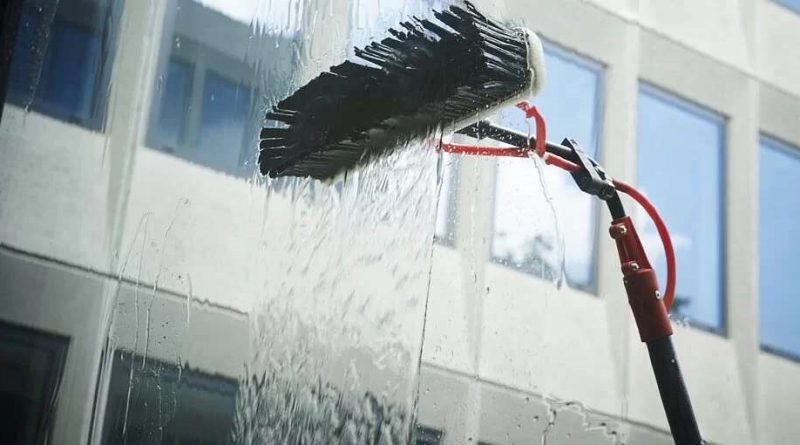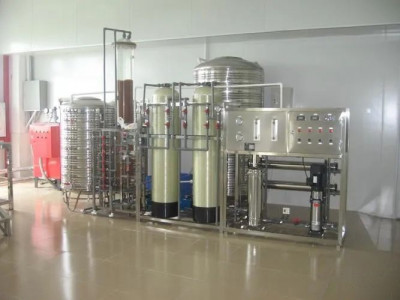قد لا تكون معالجة المياه هي أول ما يتبادر إلى الذهن عندما تفكر في غسل النوافذ ، ولكن صدق أو لا تصدق ، فإنه يلعب دورًا مهمًا في تحقيق النوافذ النظيفة المتلألئة. تصور هذا: أنت تحدق من نافذتك في يوم مشمس ، فقط لتلبية خطوط وتلطخ تعرقل وجهة نظرك. محبط ، أليس كذلك؟ حسنا ، لا! في هذه المقالة ، سوف نتعمق في أهمية معالجة المياه في غسل النوافذ وكيف يمكن أن تحول النوافذ الخاصة بك من مملة إلى مبهر. لذا احصل على ممسحة ودعنا نغطس في عالم رائع من معالجة المياه لغسل النوافذ!
أهمية معالجة المياه في غسل النوافذ.
تلعب معالجة المياه دورًا مهمًا في صناعة غسل النوافذ ، مما يوفر العديد من الفوائد وضمان نتائج التنظيف المثلى. من خلال تنفيذ طرق معالجة المياه الفعالة ، يمكن للغسالات التي يمكن أن تحسن كفاءة التنظيف وتعزيز تدابير السلامة.
أحد الفوائد الرئيسية لمعالجة المياه في غسل النوافذ هو تحسين كفاءة التنظيف. المياه التي خضعت لعمليات معالجة مثل التناضح العكسي (RO) ، والقزم (DI) ، أو ترشيح الكربون خالية من الشوائب والمعادن. يتيح هذا الماء النقي عملية تنظيف أكثر شمولية وفعالية ، تاركًا Windows بدون طيار وخالية من الخطوط.
بالإضافة إلى تحسين نتائج التنظيف ، تقلل معالجة المياه أيضًا من الخطوط وتراكم البقايا على النوافذ. عند استخدام مياه الصنبور لغسل النوافذ ، فإنه يحتوي غالبًا على معادن مثل الكالسيوم والمغنيسيوم الذي يمكن أن يترك وراءه خطوط وبقايا قبيحة. من خلال استخدام المياه المعالجة ، تتم إزالة هذه المعادن ، مما يؤدي إلى نوافذ واضحة دون أي خطوط أو بقايا.
معالجة المياه لها أيضا تأثير بيئي إيجابي في صناعة غسل النوافذ. مع المياه النقية ، هناك حاجة مخفضة للاستخدام الكيميائي أثناء عملية التنظيف. تعتمد طرق تنظيف النوافذ التقليدية غالبًا على عمال النظافة الكيميائية لإزالة البقع والأوساخ العنيدة. ومع ذلك ، مع المياه المعالجة ، يمكن تقليل هذه المواد الكيميائية أو القضاء عليها تمامًا ، مما يقلل من البصمة البيئية لعمليات غسل النوافذ.
علاوة على ذلك ، تساعد معالجة المياه في الحفاظ على الموارد الطبيعية. من خلال استخدام المياه النقية بدلاً من مياه الصنبور لغسل النوافذ ، يمكن للشركات أن تقلل بشكل كبير من استهلاك موارد المياه العذبة. يساهم جهد الحفظ هذا في الاستدامة من خلال تقليل الضغط على مصادر المياه المحلية.
عند اختيار نظام معالجة المياه الصحيح لعمليات غسل النوافذ ، ينبغي النظر في عدة عوامل. تعتبر فعالية التكلفة اعتبارًا مهمًا لأن بعض الأنظمة قد تتطلب استثمارات أولية أعلى ولكنها توفر وفورات طويلة الأجل من خلال الاستخدام الكيميائي المخفض وزيادة الكفاءة. يجب أيضًا أخذ متطلبات الصيانة في الاعتبار لضمان تشغيل سلس دون توقف كبير. أخيرًا ، ينبغي تقييم مدى ملاءمة النظام للاحتياجات المحددة لصناعة غسل النوافذ لضمان الأداء الأمثل ونتائج التنظيف المطلوبة.
فوائد معالجة المياه
تلعب معالجة المياه دورًا حاسمًا في صناعة غسل النوافذ ، مما يوفر العديد من الفوائد التي تعزز كل من تدابير كفاءة التنظيف والسلامة التي تنطوي عليها هذه المهمة. من خلال تنفيذ طرق معالجة المياه الفعالة ، مثل التناضح العكسي (RO) ، والقزم (DI) ، وترشيح الكربون ، يمكن أن تحقق غسالات النوافذ نتائج التنظيف الخالية من البقع وتقليل الخطوط وتراكم البقايا.
واحدة من الفوائد الأساسية لمعالجة المياه هي تحسين كفاءة التنظيف. عند استخدام الماء المعالج ، يمكن للغسالات النافذة إزالة الأوساخ والأوساخ والملوثات الأخرى بشكل فعال من النوافذ دون ترك أي بقع أو خطوط. تضمن المياه المعالجة الانتهاء من الوضوح البلوري ، مما يوفر للعملاء النوافذ البكر التي تعزز المظهر العام لمبانيهم.
بالإضافة إلى ذلك ، تعزز معالجة المياه تدابير السلامة أثناء عمليات غسل النوافذ. غالبًا ما تحتوي مياه الصنبور التقليدية على شوائب مثل المعادن والمواد الكيميائية التي يمكن أن تكون ضارة لكل من العمال والبيئة. من خلال استخدام طرق معالجة المياه ، تتم إزالة هذه الشوائب أو تقليلها بشكل كبير ، مما يقلل من المخاطر الصحية المحتملة للعمال ومنع الأضرار التي لحقت بالنظام الإيكولوجي المحيط.
هناك عدة أنواع من طرق معالجة المياه شائعة الاستخدام في صناعة غسل النوافذ. يتضمن التناضح العكسي (RO) تمرير الماء من خلال غشاء شبه قابل للنفاع لإزالة المواد الصلبة المذابة والجزيئات والملوثات. يستخدم القطار (DI) راتنجات التبادل الأيوني لإزالة الأيونات من الماء ، مما يؤدي إلى ماء شديد النقية مناسبة لغسل النوافذ. توظف ترشيح الكربون مرشحات الكربون المنشطة للتخلص من الكلور والرواسب والروائح والمركبات العضوية من الماء.
تأثير معالجة المياه على غسل النوافذ كبير. يضمن الماء المعالج نتائج التنظيف الخالية من البقع عن طريق منع الرواسب المعدنية على الأسطح الزجاجية. هذا يلغي الحاجة إلى تلميع أو تلميع إضافي بعد غسل النوافذ. علاوة على ذلك ، فإن المياه المعالجة تقلل من الشرائط وتراكم البقايا عن طريق إزالة الشوائب التي يمكن أن تسبب تلطيخ أو الغيوم على الأسطح الزجاجية.
بالإضافة إلى فوائدها الفورية لغسالات النوافذ ، فإن معالجة المياه لها أيضًا آثار بيئية إيجابية. يقلل استخدام الماء المعالج من الحاجة إلى عوامل التنظيف الكيميائي ، حيث يمكن للمياه المنقى وحدها إزالة الأوساخ والأوساخ بشكل فعال من النوافذ. يساهم هذا التخفيض في الاستخدام الكيميائي في بيئة أكثر صحة من خلال تقليل التلوث والضرر المحتمل للحياة المائية.
علاوة على ذلك ، تعزز معالجة المياه الحفاظ على الموارد الطبيعية. عن طريق تنقية وإعادة استخدام المياه من خلال أنظمة المعالجة ، تقلل غسالات النوافذ من اعتمادها على مصادر المياه العذبة. يساعد هذا في الحفاظ على موارد المياه الثمينة ، وخاصة في المناطق التي تشكل فيها ندرة المياه مصدر قلق.
التناضح العكسي (RO)
التناضح العكسي (RO) هو طريقة معالجة المياه فعالة للغاية تلعب دورًا مهمًا في غسل النوافذ. تتضمن هذه العملية استخدام غشاء شبه قابل للارتفاع لإزالة الشوائب والملوثات من الماء ، مما يؤدي إلى مياه نظيفة ونقية مثالية لأغراض تنظيف النوافذ.
واحدة من المزايا الرئيسية لاستخدام التناضح العكسي في غسل النوافذ هي قدرتها على توفير نتائج تنظيف خالية من البقعة. يزيل نظام RO بشكل فعال المعادن والمواد الصلبة المذابة وغيرها من الشوائب من الماء ، مما يمنع الخطوط والبقع من التكوين على النوافذ أثناء عملية التنظيف. هذا يضمن أن النوافذ تترك نظيفة ومخالية من أي بقايا أو عيوب.
بالإضافة إلى التنظيف الخالي من البقع ، يقلل التناضح العكسي أيضًا من الخطوط وتراكم البقايا. من خلال القضاء على الشوائب مثل الكالسيوم والمغنيسيوم والكلور من الماء ، يساعد المياه المعالجة RO في منع الخطوط الناجمة عن الرواسب المعدنية على النوافذ. كما أنه يقلل من احتمال تراكم البقايا مع مرور الوقت ، مما يؤدي إلى نظافة أطول وتحسين النداء البصري.
علاوة على ذلك ، فإن استخدام التناضح العكسي كطريقة معالجة المياه لغسل النوافذ له تأثيرات بيئية إيجابية. مع إزالة الشوائب من خلال هذه العملية ، هناك حاجة منخفضة للاستخدام الكيميائي أثناء تنظيف النوافذ. هذا لا يقلل من الضرر المحتمل للبيئة فحسب ، بل يساهم أيضًا في بيئة عمل أكثر أمانًا لغسالات النوافذ التي قد تتعرض للمواد الكيميائية الضارة.
علاوة على ذلك ، يساعد التناضح العكسي في الحفاظ على الموارد الطبيعية من خلال ضمان إهدار مياه أقل أثناء عملية غسل النوافذ. نظرًا لأن المياه النقية التي تم الحصول عليها من خلال RO لا تحتوي على شوائب أو ملوثات يمكن أن تتداخل مع كفاءة التنظيف ، فإن القليل من المياه مطلوبة بشكل عام لتحقيق نتائج مرضية. يتماشى الحفاظ على الموارد مع الممارسات المستدامة في هذه الصناعة.
إزالة الأيونات (DI)
يعتبر القطار (DI) أحد أساليب معالجة المياه الأكثر شيوعًا في صناعة غسل النوافذ. يلعب دورًا مهمًا في ضمان نتائج التنظيف الخالية من البقع وخالية من الخطوط ، والتي تعد ضرورية لتحقيق النوافذ النظيفة المتلألئة.
تتضمن القزحية إزالة الشوائب من المياه من خلال عملية تبادل الأيونات. تزيل هذه الطريقة بشكل فعال المعادن والأملاح المذابة التي يمكن أن تترك وراءها بقع وخيوط على النوافذ القبيحة بعد تنظيفها. من خلال القضاء على هذه الشوائب ، يضمن DI أن تكون المياه المستخدمة لغسل النوافذ نقيًا وخاليًا من أي مواد قد تتداخل مع عملية التنظيف.
تتمثل إحدى المزايا الرئيسية لاستخدام الماء منزوع الأيونات لغسل النوافذ في قدرتها على توفير نتائج تنظيف خالية من البقعة. عندما يجف مياه الصنبور العادية على سطح النافذة ، فإنه غالبًا ما يترك وراءه الرواسب المعدنية التي قد يكون من الصعب إزالتها. ومع ذلك ، لا يحتوي الماء منزوع الأيونات على أي معادن أو شوائب يمكن أن تسبب اكتشافها ، مما يؤدي إلى نوافذ بلورية دون أي علامات قبيحة.
بالإضافة إلى التنظيف الخالي من البقع ، يساعد القطار أيضًا في تقليل الخطوط وتراكم البقايا على النوافذ. يمنع غياب المعادن في الماء منزوع الأيونات الناتج عن الرواسب المعدنية التي تركت وراءها أثناء عملية التنظيف. هذا يضمن أن النوافذ ليست خالية من البقعة فحسب ، بل خالية أيضًا من الخطوط والطخات ، مما يوفر لمسة نهائية لا تشوبها شائبة.
علاوة على ذلك ، فإن استخدام المياه منزوع الأيونات في غسل النوافذ له فوائد بيئية أيضًا. نظرًا لأن الماء منزوع الأيونات لا يحتوي على أي شوائب أو معادن ، فليس هناك حاجة لاستخدام المنظفات الكيميائية أو عوامل التنظيف أثناء عملية غسل النوافذ. هذا يقلل من الاعتماد على المواد الكيميائية الضارة ويعزز الممارسات الصديقة للبيئة في هذه الصناعة.
علاوة على ذلك ، تساعد القزال الأيونات في الحفاظ على الموارد الطبيعية عن طريق تقليل هدر المياه. يمكن إعادة تدوير المياه النقية التي تم الحصول عليها من خلال هذه الطريقة وإعادة استخدامها عدة مرات قبل الحاجة إلى تجديدها. هذا يقلل من الاستهلاك الكلي لموارد المياه العذبة ويساهم في الممارسات المستدامة في عمليات غسل النوافذ.
ترشيح الكربون: طريقة فعالة معالجة المياه لغسل النوافذ
عندما يتعلق الأمر بضمان نظافة ووضوح النوافذ ، تلعب معالجة المياه دورًا مهمًا. من بين أنواع مختلفة من طرق معالجة المياه المتاحة ، يبرز ترشيح الكربون كحل فعال لغسل النوافذ. هذه الطريقة لا تحسن كفاءة التنظيف فحسب ، بل تعزز أيضًا تدابير السلامة ، مما يجعلها خيارًا مثاليًا لصناعة غسل النوافذ.
ترشيح الكربون هو عملية تتضمن تمرير المياه من خلال مرشحات الكربون المنشطة لإزالة الشوائب والملوثات. تم تصميم هذه المرشحات لفخ الجزيئات والمواد الكيميائية والروائح ، مما يؤدي إلى ماء أنظف وأعيق. من خلال القضاء على المواد غير المرغوب فيها من إمدادات المياه ، يضمن ترشيح الكربون نتائج التنظيف الخالية من البقعة ويقلل من الخطوط وتراكم البقايا على النوافذ.
واحدة من المزايا الرئيسية لترشيح الكربون هي قدرتها على توفير نتائج تنظيف خالية من البقعة. عندما يتم غسل النوافذ بالماء غير المعالج ، يمكن ترك الرواسب المعدنية وراءها بعد تبخر الماء. تظهر هذه الرواسب كبقع أو خطوط على سطح الزجاج ، مما يعرض وضوح وعلم الجمال. ومع ذلك ، من خلال استخدام المياه المصرفية في الكربون في عمليات غسل النوافذ ، يمكن القضاء على هذه البقع القبيحة بشكل فعال ، تاركًا وراء النوافذ النظيفة المتلألئة.
بالإضافة إلى نتائج التنظيف الخالية من البقع ، يساعد ترشيح الكربون أيضًا على تقليل الخطوط وتراكم البقايا على النوافذ. تزيل مرشحات الكربون المنشط الشوائب التي يمكن أن تسهم في تجويف وتشكيل البقايا أثناء عملية التنظيف. نتيجة لذلك ، يمكن للغسالات التي يمكن أن تحقق أسطح خالية من الخطوط مع عدد أقل من الجهود وضمان مستوى أعلى من رضا العملاء.
بصرف النظر عن تأثيرها المباشر على نتائج غسل النوافذ ، فإن ترشيح الكربون له آثار بيئية إيجابية. عن طريق إزالة الشوائب بشكل فعال من إمدادات المياه المستخدمة في عمليات غسل النوافذ ، فإن هذه الطريقة تقلل من الحاجة إلى الاستخدام الكيميائي. مع مياه أنظف تحت تصرفها ، يمكن أن تعتمد غسالات النوافذ على مواد كيميائية قاسية لتحقيق نتائج التنظيف المرغوبة. هذا لا يفيد البيئة فقط عن طريق الحد من التلوث الكيميائي ولكن أيضًا يعزز ظروف عمل أكثر أمانًا للمهنيين المشاركين في غسل النوافذ.
علاوة على ذلك ، يساهم ترشيح الكربون في الحفاظ على الموارد الطبيعية. من خلال علاج المياه وإزالة الشوائب ، تقلل هذه الطريقة من الحاجة إلى استهلاك المياه المفرط أثناء عمليات غسل النوافذ. ونتيجة لذلك ، يتم الحفاظ على موارد المياه الثمينة ، مما يضمن توفرها لأغراض أساسية أخرى.




